Articles
- Page Path
- HOME > J Musculoskelet Trauma > Volume 21(1); 2008 > Article
-
Original Article
- Comparison of Outcomes for Unstable Distal Radius Intraarticular Fractures: T-locking Compression Plate versus External Fixator
- Chul-Hyun Cho, M.D., Su-Won Jung, M.D., Sung-Won Sohn, M.D., Chul Hyung Kang, M.D., Ki-Cheor Bae, M.D., Kyung-Jae Lee, M.D.
-
Journal of the Korean Fracture Society 2008;21(1):51-56.
DOI: https://doi.org/10.12671/jkfs.2008.21.1.51
Published online: January 31, 2008
Department of Orthopedic Surgery, College of Medicine, Keimyung University, Daegu, Korea.
- Address reprint requests to: Chul Hyung Kang, M.D. Department of Orthopedic Surgery, Dongsan Medical Center, Keimyung University College of Medicine, 194, Dongsan-dong, Jung-gu, Daegu 700-712, Korea. Tel: 82-53-250-7729, Fax: 82-53-200-7205, os@dsmc.or.kr
Copyright © 2008 The Korean Fracture Society. All rights reserved.
This is an Open Access article distributed under the terms of the Creative Commons Attribution Non-Commercial License (http://creativecommons.org/licenses/by-nc/3.0/) which permits unrestricted non-commercial use, distribution, and reproduction in any medium, provided the original work is properly cited.
- 558 Views
- 0 Download
- 2 Crossref
Abstract
-
Purpose
- To compare the outcomes between T-locking compression plate (T-LCP) and external fixator (EF) for unstable distal radius intraarticular fractures.
-
Materials and Methods
- We retrospectively analysed the results in 22 cases with T-LCP, 20 cases with EF. We evaluated the clinical results according to the Mayo Wrist Scoring System, radiographic results.
-
Results
- The mean score was 84.6 in the T-LCP group and 80.5 in the EF group respectively. Final radiographic measurements for the T-LCP group averaged 10.5 mm radial length, 21.7° radial inclination, 9.8° volar tilt and 0.25 mm intraarticular step-off. The EF group averaged 10.1 mm radial length, 20.3° radial inclination, 6.3° volar tilt and 0.73 mm intraarticular step-off.
-
Conclusion
- Both groups showed satisfactory final clinical outcomes. But T-LCP group allowed return to daily living, resulting in early postsurgical wrist motion. By the anatomical reduction, final volar tilt, intraarticular step-off were statistically better in the T-LCP group.
- 1. Arora R, Lutz M, Fritz D, Zimmermann R, Oberladstatter J, Gabl M. Palmar locking plate for treatment of unstable dorsal dislocated distal radius fractures. Arch Orthop Trauma Surg, 2005;125:399-404.ArticlePDF
- 2. Cheon SJ, Ku JG, Lee DH, Kim HT, Suh JT. Treatment of distal radius fractures using the percutaneous K-wire reduction-fixation and external fixator. J Korean Fract Soc, 2006;19:228-235.Article
- 3. Constantine KJ, Clawson MC, Stern PJ. Volar neutralization plate fixation of dorsally displaced distal radius fractures. Orthopedics, 2002;25:125-128.Article
- 4. Cooney WP. External fixation of distal radial fractures. Clin Orthop Relat Res, 1983;180:44-49.Article
- 5. Cooney WP, Bussey R, Dobyns JH, Linscheid RL. Difficult wrist fractures. Perilunate fracture-dislocations of the wrist. Clin Orthop Relat Res, 1987;214:136-147.
- 6. Frykman G. Fracture of the distal radius including sequelae--shoulder-hand-finger syndrome, disturbance in the distal radio-ulnar joint and impairment of nerve function. A clinical and experimental study. Acta Orthop Scand, 1967;108:3+. Article
- 7. Horesh Z, Volpin G, Hoerer D, Stein H. The surgical treatment of severe comminuted intra-articular fractures of the distal radius with small AO external fixation device. A prospective three-and-one-half-year follow-up study. Clin Orthop Relat Res, 1991;263:147-153.
- 8. Huh CY, Yoon JR, Ha HS. Treatment of fractures of the distal radius with external fixator. J Korean Soc Fract, 1999;12:995-1002.
- 9. Kamano M, Honda Y, Kazuki K, Yasuda M. Palmar plating for dorsally displaced fractures of the distal radius. Clin Orthop Relat Res, 2002;397:403-408.Article
- 10. Knirk JL, Jupiter JB. Intra-articular fractures of the distal end of the radius in young abults. J Bone Joint Surg Am, 1986;68:647-659.
- 11. Lidstrom A. Fractures of distal end of the radius. A clinical and statistical study of end results. Acta Orthop Scand Suppl, 1959;41:1-118.
- 12. Orbay JL. The treatment of unstable distal radius fractures with volar fixation. Hand Surg, 2000;5:103-112.
- 13. Papadonikolakis A, Shen J, Garrett JP, Davis SM, Ruch DS. The effect of increasing distraction on distal motion after external fixation on the wrist. J Hand Surg Am, 2005;30:773-779.
- 14. Scheck M. Long term follow-up of treatment of comminuted fractures of the distal end of the radius by transfixation with kirschner wires and cast. J Bone Joint Surg Am, 1962;44:337-351.Article
- 15. Sim JC, Chung NS, Hong KD, Ha SS, Kang JH. Treatment of fractures of the distal radius using locking compression plate. J Korean Fract Soc, 2005;18:100-104.Article
- 16. Wright TW, Horodyski M, Smith DW. Functional outcome of unstable distal radius fractures: ORIF with a volar fixed-angle tine plate versus external fixation. J Hand Surg Am, 2005;30:289-299.
- 17. Zagorski JB. Comminuted fractures of the distal radius. Instr Course Lect, 1990;39:255-258.
REFERENCES
Fig. 1
(A) Preoperative radiographs show AO classification C1 fracture.
(B) Immediate postoperative radiographs show successful reduction and fixation.
(C) Radiographs at 26 months postoperatively show no significant loss of reduction.
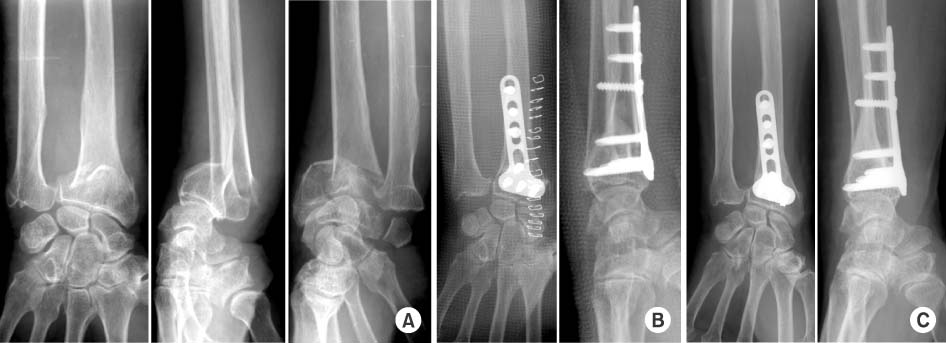
71-year-old woman with unstable distal radius intraarticular fracture was treated by open reduction and internal fixation with T-LCP.

Fig. 2
(A) Preoperative radiographs show AO classification C2 fracture.
(B) Immediate postoperative radiographs show satisfactory reduction and fixation.
(C) Radiographs at 16 months postoperatively show no significant loss of reduction.
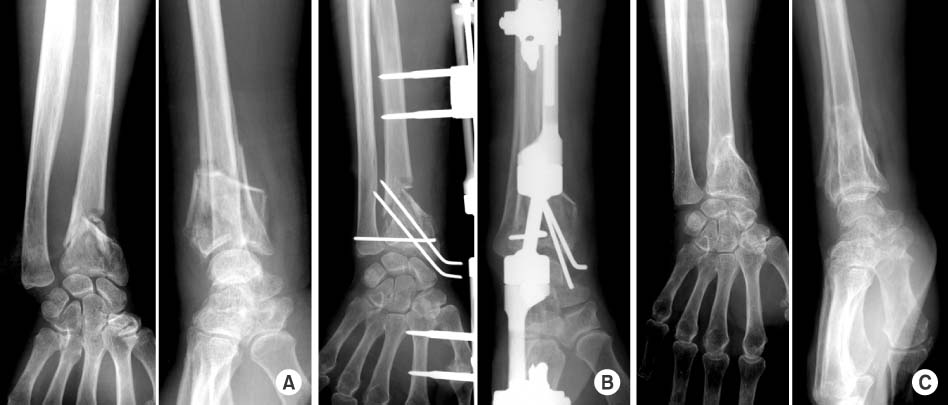
70-year-old women with unstable distal radius intraarticular fracture was treated by closed reduction and percutaneous K-wire fixation with external fixator.

Figure & Data
REFERENCES
Citations
Citations to this article as recorded by 

- Comparative Analysis of the Results of Fixed-angle versus Variable-angle Volar Locking Plate for Distal Radius Fracture Fixation
Seung-Do Cha, Jai-Hyung Park, Hyung-Soo Kim, Soo-Tae Chung, Jeong-Hyun Yoo, Joo-Hak Kim, Jung-Hwan Park
Journal of the Korean Fracture Society.2012; 25(3): 197. CrossRef - Treatment for Unstable Distal Radius Fracture with Osteoporosis -Internal Fixation versus External Fixation-
Jin Rok Oh, Tae Yean Cho, Sung Min Kwan
Journal of the Korean Fracture Society.2010; 23(1): 76. CrossRef
Comparison of Outcomes for Unstable Distal Radius Intraarticular Fractures: T-locking Compression Plate versus External Fixator


Fig. 1
71-year-old woman with unstable distal radius intraarticular fracture was treated by open reduction and internal fixation with T-LCP.
(A) Preoperative radiographs show AO classification C1 fracture.
(B) Immediate postoperative radiographs show successful reduction and fixation.
(C) Radiographs at 26 months postoperatively show no significant loss of reduction.
Fig. 2
70-year-old women with unstable distal radius intraarticular fracture was treated by closed reduction and percutaneous K-wire fixation with external fixator.
(A) Preoperative radiographs show AO classification C2 fracture.
(B) Immediate postoperative radiographs show satisfactory reduction and fixation.
(C) Radiographs at 16 months postoperatively show no significant loss of reduction.
Fig. 1
Fig. 2
Comparison of Outcomes for Unstable Distal Radius Intraarticular Fractures: T-locking Compression Plate versus External Fixator
Clinical details of 42 patients with unstable distal radius intra-articular fracture
Results according to Mayo wrist score system
Results according to the radiographic evaluation
*S.D.: Standard deviation.
Arthritic grading system of Knirk and Jupiter and results of this study
Table 1
Clinical details of 42 patients with unstable distal radius intra-articular fracture
Table 2
Results according to Mayo wrist score system
Table 3
Results according to the radiographic evaluation
*S.D.: Standard deviation.
Table 4
Arthritic grading system of Knirk and Jupiter and results of this study

 E-submission
E-submission KOTA
KOTA TOTA
TOTA TOTS
TOTS
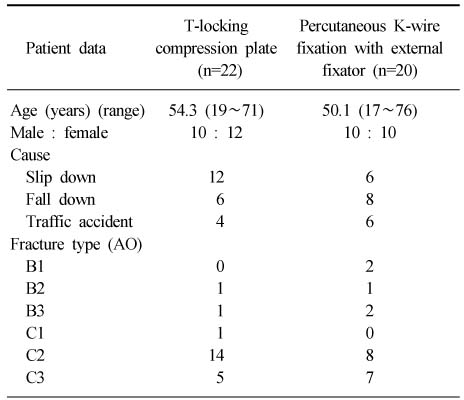
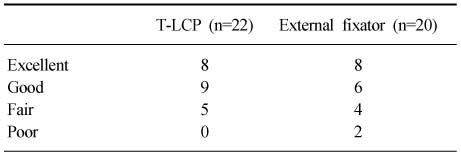

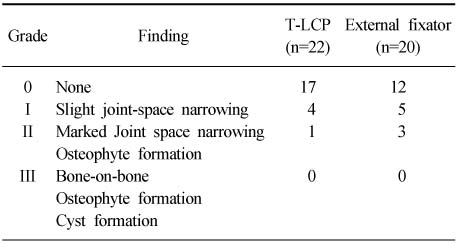
 Cite
Cite

